2022 Volvo XC40 Adaptive cruise control
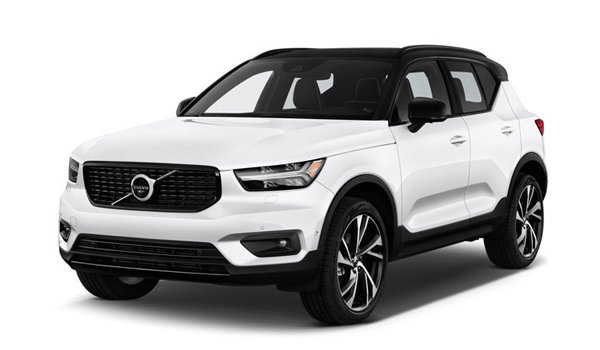
Adaptive cruise control
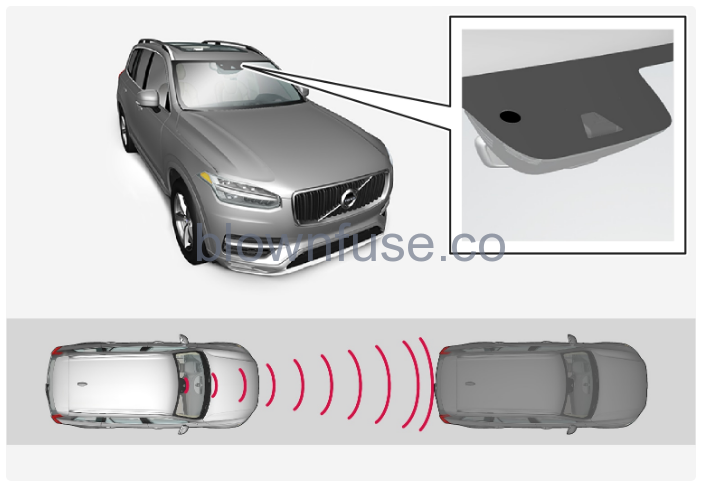 The camera and radar unit measure the distance to the vehicle ahead.
The camera and radar unit measure the distance to the vehicle ahead.Adaptive cruise control can provide a more relaxing driving experience on long journeys on motorways and long straight main roads in smooth traffic flows.
The driver selects the desired speed and a time interval for the vehicle ahead. If the camera and radar unit detect a slower vehicle in front of the car, the speed is adapted automatically via the preset time interval to the vehicle ahead. When the road is clear again the car returns to the selected speed.
The adaptive cruise control aims to:
- regulate the speed smoothly. In situations that demand sudden braking, the driver must brake himself/herself. This applies in cases of large speed differences or if the vehicle in front brakes suddenly. Due to the limitations of the radar unit, braking may come unexpectedly or not at all.
- follow the vehicle ahead in the same lane at a time interval set by the driver. If the radar unit cannot see any vehicle in front then the car will instead maintain the speed stored by the driver. This also takes place if the speed of the vehicle ahead increases and exceeds the stored speed.
Steep roads and/or heavy load
Bear in mind that the adaptive cruise control is primarily intended for use when driving on level road surfaces. The function may have difficulty in keeping the correct distance from the vehicle ahead when driving on steep downhill slopes – in which case, be extra attentive and ready to brake. Do not use adaptive cruise control if the car has a heavy load or a trailer is connected to the car.
- This is not a collision avoidance system. The driver is always responsible and must intervene if the system does not detect a vehicle ahead.
- The function does not brake consistently for humans or animals, and neither for small vehicles such as bicycles and motorcycles. Nor for low trailers, oncoming, slow or stationary vehicles, and objects.
- Do not use the function in demanding situations, such as in city traffic, at junctions, on slippery surfaces, with a lot of water or slush on the road, in heavy rain/snow, in poor visibility, on winding roads, or on slip roads.
- The function is supplementary driver support intended to facilitate driving and make it safer – it cannot handle all situations in all traffic, weather, and road conditions.
- The driver is advised to read all sections in the Owner’s Manual that relate to this function to learn about factors such as its limitations and what the driver should be aware of before using the system.
- Driver support functions are not a substitute for the driver’s attention and judgment. The driver is always responsible for ensuring the car is driven in a safe manner, at the appropriate speed, at an appropriate distance from other vehicles, and in accordance with current traffic rules and regulations.
This function uses the car’s camera and radar units, which have certain general limitations.
Maintenance of driver support components must only be performed at a workshop – an authorized Volvo workshop is recommended.
Symbols and messages for adaptive cruise control
| Symbol | Message | Specification |
|---|---|---|
 |
The symbol is lit | The car is maintaining the stored speed. |
 |
Adaptive Cruise Contr.
Unavailable The symbol is extinguished |
Adaptive cruise control is set to standby mode. |
 |
Adaptive Cruise Contr.
Service required The symbol is extinguished |
The system does not function as it should. A workshop should be contacted – an authorized Volvo workshop is recommended. |
 |
Windscreen sensor
Sensor blocked, see Owner’s manual |
Clean the windscreen in front of the camera and radar unit’s detectors. |
A text message can be cleared by briefly pressing the ![]() button, located in the center of the steering wheel’s right-hand keypad.
button, located in the center of the steering wheel’s right-hand keypad.
If a message remains, contact a workshop – an authorized Volvo workshop is recommended.
Standby mode for adaptive cruise control
Standby mode means that the function is selected in the driver display but not activated. Adaptive cruise control does not then regulate the speed or distance to the vehicle in front.
Standby mode on driver intervention
The adaptive cruise control is deactivated and set in standby mode if any of the following occurs:
- The foot brake is used.
- The gear selector is moved to the N position.
- The driver maintains a speed higher than the stored speed for longer than 1 minute.
- The clutch pedal is held depressed for longer than 1 minute – applies to cars with a manual gearbox.
A temporary increase in speed with the accelerator pedal, e.g. during overtaking, does not affect the setting – the car returns to the last stored speed when the accelerator pedal is released.
- With the adaptive cruise control in standby mode, the driver must intervene and regulate both speed and distance to the vehicle ahead.
- When the adaptive cruise control is in standby mode and the car comes too close to a vehicle ahead, the driver may be warned of the short distance by the Distance Warning function instead.
Automatic standby mode
With automatic standby mode, the driver is warned via an acoustic signal and a message in the driver’s display.
- The driver must then regulate the car’s speed, apply the brakes as needed and maintain a safe distance from other vehicles.
Automatic standby mode may be engaged in the event of one of the following:
- One of the systems that Adaptive cruise control is dependent on stops working, e.g. stability control / anti-skid (ESC).
- The driver opens the door.
- The driver takes off the seatbelt.
- The engine speed is too low/high.
- One or more wheels lose traction.
- The brake temperature is high.
- The parking brake is applied.
- The camera and radar unit are covered by e.g. snow or heavy rainfall (camera lens/radio waves are blocked).
- The speed is below 5 km/h (3 mph) and ACC is uncertain whether the vehicle ahead is a stationary vehicle or an object, such as a speed bump.
- The speed is below 5 km/h (3 mph) and the vehicle ahead turns off so that ACC no longer has a vehicle to follow.
- The speed is reduced to below 30 km/h (20 mph) – only applies to cars with a manual gearbox.
Automatic braking with cruise control functions
Brake function in slow queues and while stationary
For shorter stops in connection with creep mode in slow traffic or at traffic lights, driving is automatically resumed if the stops do not exceed approx. 3 seconds – if it takes longer before the vehicle in front starts moving again then the driver support function is set in standby mode with automatic braking.
The function is reactivated in one of the following ways:
- Press the steering wheel button.
- Depress the accelerator pedal.
The function resumes following the vehicle ahead if it starts moving forward within approx. 6 seconds.
Warning
A significant increase in speed may follow when the speed is resumed with the steering wheel button.
Warning
The driver supports only warn of obstacles that their radar unit has detected – hence a warning may not be given, or it may be given with a certain delay.
- Never wait for a warning or intervention. Apply the brakes when the situation requires.
The driver supports can hold the car stationary for a maximum of 10 minutes – then the parking brake is applied and the function is disengaged.
Before the driver support can be reactivated, the parking brake must be released.
Cessation of automatic braking
In some situations, automatic braking ceases on coming to a standstill and the function is set in standby mode. This means that the brakes are released and the car may start to roll – the driver must therefore intervene and brake the car himself/herself to keep it stationary.
This may take place in any of the following situations:
- The driver puts his/her foot on the brake pedal.
- The parking brake is applied.
- The gear selector is moved to the P, N, or R position.
- The driver sets the adaptive cruise control or Pilot Assist to standby mode.
Automatic activation of the parking brake
The Parking brake is applied if the function is holding the car stationary with the foot brake and:
- The driver opens the door or takes off his/her seatbelt.
- The function has kept the car stationary for more than approx. 10 minutes.
- The brakes have overheated.
- The driver switches the engine off.
Setting the stored speed for cruise control functions
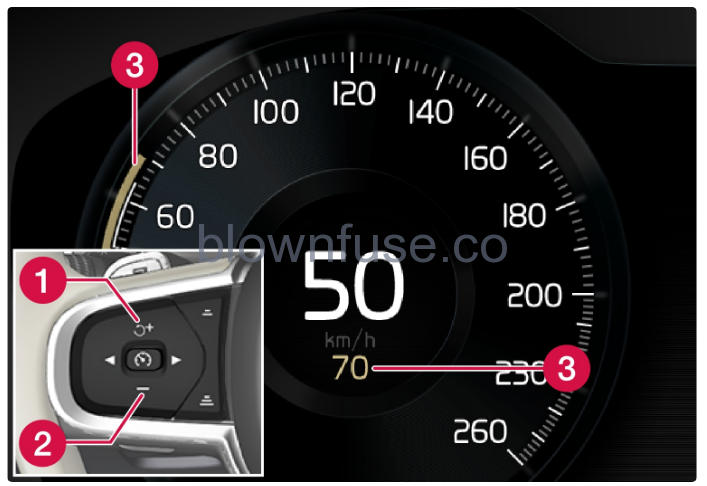
| 1 | |
| 2 | |
| 3 | Stored speed |
Change a set speed with short presses on the steering wheel buttons ![]() (1) or
(1) or ![]() (2) or by pressing and holding them.
(2) or by pressing and holding them.
- Short presses: Each press changes the speed in increments of +/- 5 km/h (+/- 5 mph).
- Press and hold: Release the button when the speed indicator (3) has moved to the desired speed.
The speed setting after the last button press is stored in the memory.
Effect of the accelerator pedal
If the driver increases the car’s speed using the accelerator pedal before pressing the steering wheel button ![]() (1), the speed stored will be the car’s speed when the button is depressed, provided the driver’s foot is on the accelerator pedal at the moment when the button is depressed. A temporary increase in speed with the accelerator pedal, e.g. during overtaking, does not affect the setting – the car returns to the last stored speed when the accelerator pedal is released.
(1), the speed stored will be the car’s speed when the button is depressed, provided the driver’s foot is on the accelerator pedal at the moment when the button is depressed. A temporary increase in speed with the accelerator pedal, e.g. during overtaking, does not affect the setting – the car returns to the last stored speed when the accelerator pedal is released.
Possible speed
Automatic gearbox
- The driver support functions can follow another vehicle at speeds from 0 km/h up to 180 km/h (112 mph).
- Pilot Assist can give steering assistance from almost stationary up to 140 km/h (87 mph).
- Note that the lowest programmable speed is 30 km/h (20 mph) – even though it is capable of following another vehicle down to 0 km/h, a speed lower than 30 km/h (20 mph) cannot be selected/stored.
Manual gearbox
- The driver support functions can follow another vehicle at speeds from 30 km/h (20 mph) up to 180 km/h (112 mph).
- Pilot Assist can give steering assistance from 30 km/h (20 mph) up to 140 km/h (87 mph).
- The lowest programmable speed is 30 km/h (20 mph) – the maximum speed is 200 km/h (125 mph).
Change of target with cruise control functions
Change of target
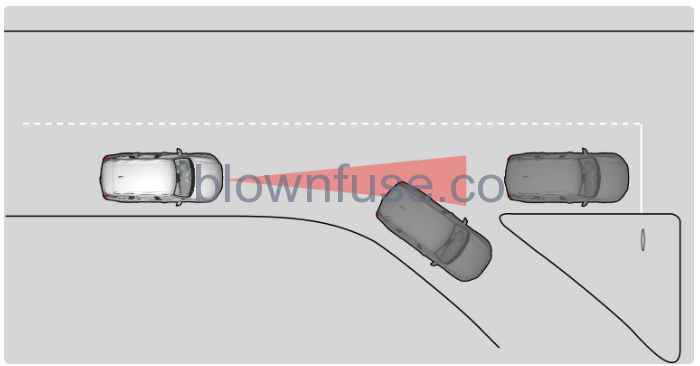 If the target vehicle in front suddenly turns then there may be stationary traffic in front.
If the target vehicle in front suddenly turns then there may be stationary traffic in front.When the driver supports are following another vehicle at speeds below 30 km/h (20 mph) and changes the target vehicle – from a moving vehicle to a stationary vehicle – the driver supports will slow down for the stationary vehicle.
When the driver supports are following another vehicle at speeds in excess of approx. 30 km/h (20 mph) and the target is changed from a moving vehicle to a stationary vehicle, the driver support will ignore the stationary vehicle and instead accelerate to the stored speed.
- The driver must then intervene him/herself and brake.
Automatic standby mode with the change of target
The driver supports are disengaged and set in standby mode:
- when the speed is below 5 km/h (3 mph) and the driver supports are uncertain whether the target object is a stationary vehicle or another object, such as a speed bump.
- when the speed is below 5 km/h (3 mph) and the vehicle ahead turns off so that the driver supports no longer has a vehicle to follow.
Setting time interval to vehicle ahead
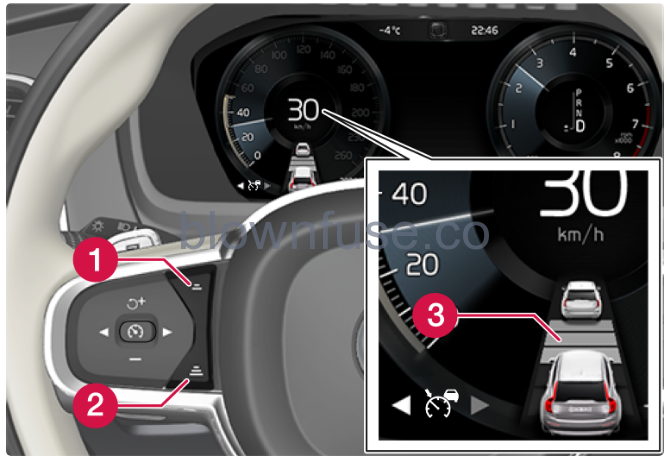 Control for a time interval.
Control for a time interval.- Decrease time interval
- Increase time interval
- Distance indicator
- Press the steering wheel button (1) or (2) to increase or decrease the time interval.
- The distance indicator (3) shows the current time interval.
- Different time intervals to the vehicle in front can be selected and shown in the driver display as 1-5 horizontal lines – the more lines the longer the time interval. One line represents about 1 second to the vehicle in front, and 5 lines represent about 3 seconds.
- The adaptive cruise control allows the time interval to vary significantly in certain situations in order to allow the car to follow the vehicle in front smoothly and comfortably. At low speed, when the distances are short, the adaptive cruise control increases the time interval slightly.
When the symbol in the driver display shows a car and a steering wheel, Pilot Assist follows a vehicle in front at a preset time gap.
When only one steering wheel is shown, there is no vehicle within a reasonable distance ahead.
Note
When the symbol in the driver display shows two cars, adaptive cruise control is following the vehicle in front at a pre-set time interval.
When only one car is shown, there is no vehicle within a reasonable distance ahead.
- The higher the speed the longer the calculated distance in meters for a given time interval.
- Only use the time intervals permitted by local traffic regulations.
- If the driver supports do not seem to respond with a speed increase when activated, it may be because the time window to the vehicle ahead is shorter than the set time window.
- Only use a time window that suits the current traffic conditions.
- The driver should be aware that short time windows limit the amount of time available to react and take action in an unexpected traffic situation.
Warning from cruise control functions in the event of a collision risk
 Audio and symbol for collision warning
Audio and symbol for collision warning- Acoustic signal in the event of a risk of collision
- Warning signal in the event of a risk of collision
- Distance measurement with the camera and radar units
- Adaptive cruise control and Pilot Assist use approx. 40% of the capacity of the foot brake.
- If the car needs to be braked more heavily than the driver support is capable of and the driver does not brake, the warning lamp and acoustic warning are activated to alert the driver that immediate intervention is required.
Warning
The driver support systems only warn of vehicles that their radar unit has detected – hence a warning may not be given, or it may be given with a certain delay. Never wait for a warning. Apply the brakes when the situation requires.

